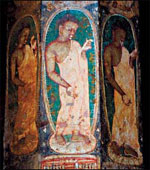Mumbai magic
The Kailasa Temple, a world treasure wrested from rock northeast of Mumbai more than a millennium ago, is part of a World Heritage site that encompasses 34 cave shrines. |
Capturing Mumbai in a few sentences is a tall order. Add in its home state of Maharashtra and the bordering state of Goa, and the order becomes taller still. The region is a sprawling, chaotic mix of wealth and poverty, of commercial and financial clout offset by an outlying paradise of quiet beaches and pastoral mountains and farmland.
India's "City of Dreams" is a natural first stop for any visit to the western coast. Although best known as India's business capital and home to the world's largest movie industry, Mumbai offers so much more.
My visit starts at one of its icons, the Gateway of India. A horizon-obscuring arch built by the English at the edge of Mumbai's harbor, it commemorates the 1911 arrival in India of England's King George V and Queen Mary.
The British Empire had major ambitions when it granted the East India Company the charter for all trade with the "East Indies", including the string of islands that constituted the original Bombay (the islands were eventually merged).
The Gateway was where ships unloaded many of the notable merchants, dignitaries and migrants who helped shape the brain-spinning city Mumbai has become. These days the Gateway and its park provide a stage for snake charmers, jugglers, magicians and other street performers.
A mini Lord Krishna and friends honor the Hindu god's birthday. |
Originally from Iran, Parsi immigrants settled and prospered along India's west coast. By the time the British colonized the town, Parsis were India's top capitalists, funding Mumbai's cultural institutions.
"Now," says Suresh, "it's time to see how others in Mumbai live."
East of us sits bustling Crawford Market, a polychrome exuberance of fruits, spices and more displayed in a cavernous colonial-Gothic-with-Indian-touches building.
Watching vendors and customers bargain over mangoes and marigolds is an eye-opener, but a bigger eye-opener may well be the frieze over the market's main entrance. It was designed by Bombay schoolmaster John Lockwood Kipling, father of Rudyard the author of Kim and The Jungle Book, who was born in Mumbai.
We continue south to another colonial show-stopper: Victoria Terminus (renamed Chhatrapati Shivaji Terminus), a glorious confection of a train station erected in 1888.
All domes, arches, turrets and filigree, it was designated a World Heritage site in 2004, cited as "an outstanding example of Victorian Gothic Revival architecture ... blended with themes deriving from Indian traditional architecture."
My afternoon ends at Chowpatty Beach not a place to swim but a popular sunset gathering point for Mumbai's citizenry. Families, lovers, business partners all stroll the sand here, munching seasoned puffed rice from paper cones.
Ellora, also a World Heritage site, boasts 34 grottoes, hewn and decorated between the 7th and 11th centuries AD. |
I'm standing in a ballroom-size cavern carved out of a hillside some 1,500 years ago. In darkness punctuated by the echo of dripping water I make out graceful support columns. Small rooms monks' dorm cells scallop the walls. This place feels eternal as only stone buildings can.
I'm at Ajanta Caves, about 100 kilometers north of the city of Aurangabad, which is 380 kilometers northeast of Mumbai. A complex of 30 caves that were carved and decorated by monks and workers between the 2nd century BC and the 6th century AD, Ajanta houses some of Buddhism's great art.
A World Heritage site, its location couldn't be more dramatic: The caves were carved halfway up a horseshoe-shaped cliff face that was cut by the Waghora River. But what really makes these caves are their paintings. Crafted with hand-ground tempera over plaster and mud, they coat the murky interior, illustrating lessons in the life of Buddha.
I spot a bodhisattva hurling his thunderbolts and, elsewhere, holding a lotus blossom signifying compassion. In gilded hues, another wall shows Buddha dividing himself 1,000 times. Still other paintings depict meaningful events in the life of Buddha as he evolved from a mortal prince to a transcendent being.
transcendent being.
Each of Ajanta's caves is unique in scale, age and craftsmanship. Some house huge stupas (Buddhist shrines); others have intricately carved facades, bas-reliefs, and coffered ceilings.
The Ajanta Caves rank with the world's wonders, but Aurangabad's environs hold another. About 32 kilometers northwest of the city I arrive at the Ellora Caves, also a World Heritage site. Arrayed halfway up a hill, Ellora boasts 34 grottoes, hewn and decorated between the 7th and the 11th centuries AD.
Unlike Buddhist Ajanta, however, Ellora's caves house artistic depictions of three religions: Buddhism, Hinduism and Jainism.
The New York Times Syndicate
(China Daily 02/08/2007 page19)

















